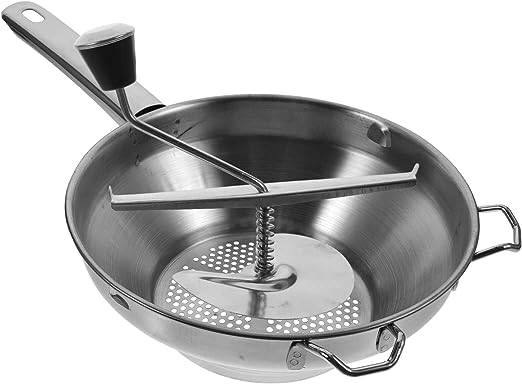A food mill is a kitchen gadget that resembles a large sieve or strainer but with significant enhancements. It typically consists of a bowl-shaped container with small perforations on the bottom and sides.
Table of Contents
What is a Food Mill?
A food mill is a kitchen tool that might not be as common nowadays, but it’s a hidden gem in the culinary world.
This simple yet ingenious device is perfect for those who appreciate homemade sauces, purees, and soups. So, what exactly is a food mill?
In its most basic form, a food mill consists of three main components: a bowl or hopper at the top, a perforated disk or screen in the middle, and a handle or crank on the side. The bowl serves as the container for your ingredients, while the disk acts as a filter to separate any unwanted solids from your mixture.
The handle or crank allows you to rotate the disk and apply gentle pressure to push your ingredients through the holes. Food mills come in various types and sizes to cater to different needs.
Some models are manual with hand-cranked mechanisms, while others are electric-powered for faster processing. You can find food mills made from materials like stainless steel or plastic.
Stainless steel models are more durable and ideal for heavy-duty tasks, while plastic ones are lightweight and convenient for occasional use. The primary purpose of a food mill is to strain and puree cooked foods effortlessly.
It’s an excellent tool for removing seeds, skins, fibrous materials, and lumps from fruits and vegetables while preserving their natural flavors and textures. Whether you want silky smooth tomato sauce without seeds or creamy mashed potatoes sans lumps – the food mill has got you covered!
Additionally, it can also be used to make baby food by creating fine purees suitable for infants. With its versatility and efficiency in producing consistent results every time, it’s no wonder that home cooks consider the food mill an essential tool in their kitchen arsenal.
Types of Food Mills
When it comes to food mills, there are different types available on the market. Each type has its unique features and purposes, catering to various culinary needs. Let’s explore some of the common types of food mills you can find:
1. Rotary Food Mill: This type of food mill is perhaps the most popular and widely used among home cooks and professional chefs. It consists of a cone-shaped sieve with small perforations connected to a handle with a rotating mechanism.
As you turn the handle, the food is pushed against the sieve, effectively straining out any unwanted seeds, skins, or fibers while retaining the smooth puree or sauce. Rotary food mills usually come with interchangeable discs with different-sized holes for varying textures.
2. Ricer Food Mill: If you’re in need of finely mashed ingredients like potatoes or fruits, then a ricer food mill should be your go-to tool. It typically features a hopper-like container on one end and a handle on the other.
By squeezing down on the handle, your ingredients are forced through tiny holes at the bottom of the hopper, producing fluffy and lump-free results.
3. Electric Food Mill: For those who prefer convenience and efficiency in their kitchen, an electric food mill might be just what you need.
These motorized appliances work similarly to rotary food mills but eliminate manual effort by automating the process for you. With different settings to control speed and texture consistency, electric food mills can save you time while still achieving excellent results.
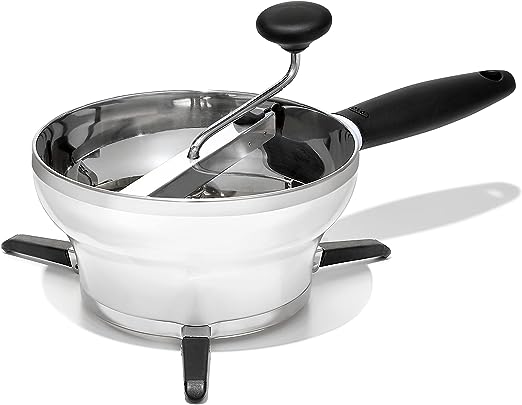
Uses of Food Mill
The Food Mill is a versatile kitchen tool that can be used in various ways. Whether you’re looking to make smooth sauces, creamy purees, or perfectly textured mashed potatoes, the Food Mill has got you covered. Let’s explore some of the fantastic uses of this handy device.
One of the primary uses of a Food Mill is for making homemade sauces. Whether it’s tomato sauce, apple sauce, or even berry coulis, the Food Mill can help you achieve that perfectly smooth consistency.
Cook your ingredients until soft, then pass them through the mill using the medium disc. The seeds and skins will be left behind while a luscious sauce comes out from the flesh.
If you have little ones at home who are just starting on solids, you’ll appreciate how easy it is to create wholesome and nutritious meals using this tool. Steam fruits or vegetables until tender and then pass them through the mill using a fine disc to remove any tough fibers or skins.
You’ll have smooth purees in no time – perfect for introducing your baby to new flavors and textures. The Food Mill also excels at creating fluffy and lump-free mashed potatoes.
We all know how frustrating it can be when we end up with lumpy spuds despite our best efforts! With a Food Mill, achieving that creamy consistency becomes effortless.
After boiling your potatoes until tender, pass them through the mill using either the medium or coarse disc, depending on your preference for texture. The result?
Silky-smooth mashed potatoes will have everyone at your dinner table asking for seconds. There are numerous uses for a Food Mill that make it an essential tool in any kitchen arsenal.
From silky sauces to baby food and perfect mashed potatoes, this device guarantees consistently smooth results every time. So why settle for store-bought sauces and lumpy mashed potatoes when you can easily create culinary masterpieces using a Food Mill?
Setting up a Food Mill
When setting up your food mill, the process is pretty straightforward.
Before you begin, make sure you have all the necessary components ready: the food mill itself, the disc(s) that will be used for processing, and a large bowl or pot to collect the processed food. Start by placing the food mill on a stable surface, such as a countertop or table.
Make sure it is secure and won’t wobble during use. Next, select the appropriate disc for your desired texture.
Most food mills come with multiple discs that allow you to choose between fine, medium, or coarse textures. If you’re unsure which disc to use, refer to your recipe for guidance.
Once you’ve chosen the right disc, please insert it into the bottom of the food mill. Now it’s time to assemble your food mill.
Take hold of the handle and position it over the top of the bowl or pot where you’ll be collecting your processed food. Ensure that both sides of the handle are securely attached to the body of the food mill by aligning and sliding them into place until they click into position.
It’s crucial to check that everything is firmly connected before proceeding. Once your food mill is properly assembled, please take a moment to familiarize yourself with its operation before diving in.
Get acquainted with how turning the handle operates its mechanism and how rotating pressure affects output consistency. This will help ensure smoother usage in subsequent steps.
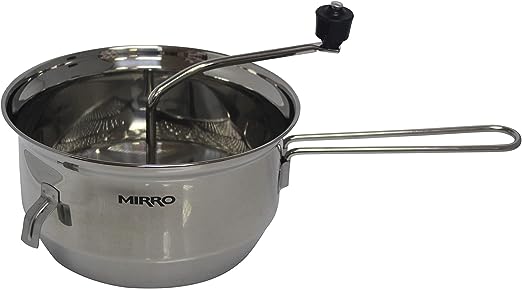
Steps to use a Food Mill
Using a food mill may seem intimidating at first, but once you get the hang of it, you’ll wonder how you ever cooked without one. Here are the steps to use a food mill and achieve perfectly smooth purees and sauces:
1. Prepare your ingredients: Before starting, ensure your ingredients are properly prepared for processing in the food mill.
For example, if you’re making tomato sauce, blanch the tomatoes to remove their skins and remove any seeds or tough cores if you’re making applesauce, peel and core the apples.
This step may vary depending on the recipe you’re following.
2. Set up your food mill: Place it over a large bowl or pot that can catch the processed puree or sauce as it passes through the mill’s holes.
Make sure to choose a bowl or pot that is stable and secure.
3. Begin milling: Take a portion of your prepared ingredients and place them into the food mill’s hopper or bowl section.
Then turn the handle in a clockwise direction to start milling.
4. Apply gentle pressure: As you rotate the handle, apply gentle downward pressure on the food with a wooden spoon or pestle to help push it through the holes of the mill’s disc.
5. Continue milling: Keep turning the handle steadily and applying light pressure until all your ingredients have passed through, leaving behind only skins, seeds, or any unwanted solids.
6. Scrape off remaining puree: After milling all of your ingredients, check if there is any residual left on top of the disc inside your food mill.
Use a spatula or spoon to scrape off as much as possible before removing it from atop.
7. Clean up: Once you’ve finished using your food mill, disassemble its parts for cleaning promptly—most models are dishwasher safe—or wash them by hand using warm soapy water.
By following these steps diligently each time you use a food mill, you’ll quickly become proficient at achieving silky-smooth purees and sauces. Don’t be discouraged if it takes a few attempts to master the technique; practice makes perfect, and the results are well worth the effort!
Best Food Mills for Homemade Sauces and Soups
When making homemade sauces and soups, having a reliable food mill is essential. Whether you’re a seasoned chef or an ambitious home cook, investing in the best food mill will make your culinary adventures much easier.
Mirro 50024 Foley Stainless Steel
When it comes to finding the perfect food mill for your kitchen, the Mirro 50024 Foley Stainless Steel Healthy Food Mill Cookware is worth considering. This high-quality food mill is designed to make your cooking experience a breeze. Made from durable stainless steel, it is built to last and withstand the test of time.
One of the standout features of the Mirro 50024 Foley Food Mill is its versatility. Whether you want to make smooth purees, creamy sauces, or silky soups, this food mill has got you covered.
With three interchangeable stainless steel discs of different sizes (fine, medium, and coarse), you have complete control over the texture and consistency of your creations. Not only does this food mill perform exceptionally well, but it also prioritizes your health.
The stainless steel construction ensures no harmful chemicals or toxins leach into your food during processing. Plus, it is dishwasher safe for easy cleanup – a huge bonus for busy home cooks.
OXO Good Grips Food Mill
The OXO Good Grips Food Mill is an exceptional kitchen tool that stands out for its superior quality and innovative design. This food mill is constructed with a combination of stainless steel and durable plastic, ensuring longevity and ease of use with its comfortable non-slip handle and secure grip.
One notable feature of the OXO Good Grips Food Mill is its interchangeable discs, which offer various grinding options to suit your needs. It comes with three different discs: fine, medium, and coarse.
The fine disc is perfect for creating silky smooth purees and sauces, while the medium disc works well for mashing fruits or vegetables with a slightly chunkier texture. The coarse disc provides an ideal consistency for preparing homemade salsa or chunky tomato sauce.
These interchangeable discs make it incredibly versatile, allowing you to easily achieve the desired results. Cleaning the OXO Good Grips Food Mill is no hassle either.
All the parts are dishwasher safe, making maintenance a breeze after cooking up a storm in the kitchen. Additionally, this food mill features a unique foldable design that allows for compact storage when not in use.
Its sleek appearance won’t occupy much space in your kitchen cabinets or drawers. Whether you’re a seasoned chef or an amateur cook looking to elevate your culinary skills, the OXO Good Grips Food Mill is an excellent investment.
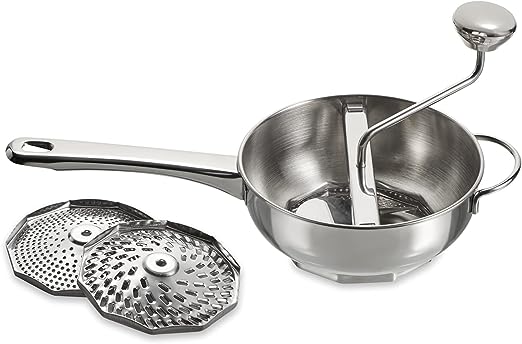
Weston Stainless Steel Food Mill
The Weston Stainless Steel Food Mill is one of the top choices for those serious about making homemade sauces and purees. With its sleek stainless steel design, this food mill looks great in your kitchen and delivers excellent performance.
It is designed to be durable and long-lasting, ensuring you can rely on it for years. One standout feature of the Weston Stainless Steel Food Mill is its three interchangeable discs.
These discs allow you to choose from various textures depending on your needs. The fine disc is perfect for creating silky smooth sauces and purees, while the medium disc works well for slightly chunkier textures like applesauce or mashed potatoes.
The coarse disc is great for straining seeds and skins from fruits or vegetables. Using the Weston Stainless Steel Food Mill is a breeze thanks to its easy-to-use handle and sturdy base.
Simply attach it to a countertop or tabletop using the included clamp, and you’re ready to start milling! The handle turns smoothly, allowing you to process your ingredients with minimal effort effortlessly.
Plus, the wide bowl accommodates large quantities of food, making it ideal for canning or preserving. Customers who have used the Weston Stainless Steel Food Mill rave about its performance and durability.
Many reviewers praise how easy it is to assemble and disassemble for cleaning, with all parts being dishwasher safe. The stainless steel construction ensures it remains stain-resistant even after repeated use with vibrant-colored foods like tomatoes or berries.
If you’re searching for a reliable food mill that combines functionality with durability, look no further than the Weston Stainless Steel Food Mill. Its interchangeable discs provide versatility in texture options, while its sturdy construction guarantees long-lasting performance.
Cuisipro Deluxe Food Mill
The Cuisipro Deluxe Food Mill is a must-have kitchen tool for those who enjoy making homemade sauces and purees. With its sleek design and sturdy construction, this food mill offers functionality and durability. Made with high-quality stainless steel, it ensures your food is processed efficiently and effectively.
One of the standout features of the Cuisipro Deluxe Food Mill is its interchangeable discs. This allows you to choose between three different sizes for various textures of your pureed foods.
Whether you want a smooth sauce or a chunky salsa, this food mill can deliver. The discs are easy to switch out, making it convenient to adapt to different recipes on the fly.
Another advantage of the Cuisipro Deluxe Food Mill is its comfortable handle. The ergonomically designed handle provides a secure grip, allowing for effortless milling even when handling large batches of ingredients.
You won’t have to worry about straining your hand or wrist using this food mill. In addition to its exceptional performance, the Cuisipro Deluxe Food Mill is also easy to clean.
The entire unit can be disassembled quickly, and all parts are dishwasher-safe. This saves you precious time in the kitchen so that you can focus on enjoying your delicious creations rather than scrubbing pots and pans.
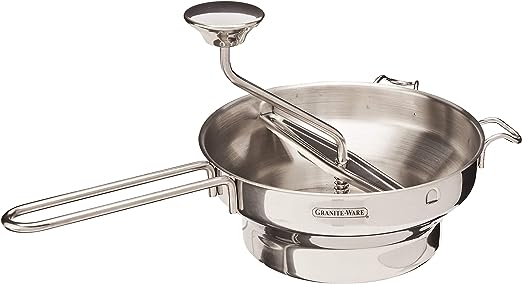
Granite Ware Stainless Steel Deluxe Food Mill
The Granite Ware Stainless Steel Deluxe Food Mill is a true gem in the kitchen. With its sleek and durable stainless steel construction, this food mill is built to last.
The high-quality material ensures it won’t rust or corrode, even with frequent use. Its sturdy design also provides stability during the food milling process, so you can focus on creating delicious sauces and purees without any worries.
One of the standout features of the Granite Ware Stainless Steel Deluxe Food Mill is its interchangeable discs. This versatile tool has three different discs: a coarse disc for chunkier textures, a medium disc for smooth sauces, and a fine disc for silky purees.
Whether you want to make homemade tomato sauce with just the right consistency or create velvety mashed potatoes, this food mill has got you covered. Another great aspect of this food mill is its large capacity.
With a 2-quart capacity, it can simultaneously handle large batches of food, saving you time and effort in the kitchen. The stainless steel bowl is deep enough to prevent spills while accommodating generous ingredients.
Plus, it comes with an easy-to-grip handle that allows for smooth cranking, ensuring a seamless milling process from start to finish. In addition to its impressive functionality and durability, the Granite Ware Stainless Steel Deluxe Food Mill also boasts easy cleanup.
Food Mill Recipes
From velvety tomato sauce to silky smooth applesauce, the food mill is your secret weapon for creating irresistibly tasty dishes.
Tomato Sauce
When it comes to making delicious homemade tomato sauce, a food mill can be your secret weapon. Using a food mill helps to remove the seeds and skin from the tomatoes, giving your sauce a smooth and velvety texture.
Plus, it saves you the hassle of peeling and deseeding tomatoes by hand.
To start, gather your ripe tomatoes and wash them thoroughly. You’ll want to choose meaty varieties like Roma or San Marzano for the best results.
Cut each tomato in half and remove any tough stems or blemishes. Then, place a large bowl or pot underneath the food mill’s strainer basket to catch the puree.
Next, with one tomato half at a time, press it firmly against the strainer basket of the food mill and turn the handle clockwise. As you rotate the handle, you’ll notice that the seeds and skin are separated from the pulp of the tomato.
The pulp will pass through small holes in the strainer basket and collect in your bowl or pot below. Continue working through your tomato halves until you have processed them through the food mill.
Remember to periodically clean out any accumulated residue from inside the strainer if necessary. Once finished, you’ll be left with a vibrant red puree ready to be transformed into delicious tomato sauce.
Then add your tomato puree, salt, pepper, and dried herbs like oregano or basil for added flavor. Let the sauce simmer gently for about 30 minutes to an hour, stirring occasionally to prevent sticking or burning.
This will give the flavors a chance to meld together and the sauce to thicken to your desired consistency. Taste and adjust the seasoning as needed, adding a pinch of sugar if it’s too acidic.
Once your tomato sauce has reached its desired consistency and flavor, you can use it immediately or let it cool before storing it in an airtight container in the refrigerator or freezer. This homemade tomato sauce made with the help of a food mill will surely elevate any pasta dish, pizza, or lasagna to new heights of gastronomic delight.
Applesauce
When making homemade applesauce, a food mill can be your best friend in the kitchen. Making applesauce can be tedious if you have to peel and core each apple by hand, but with a food mill, the task becomes much easier and more efficient.
Here’s how to use a food mill to make delicious, chunky applesauce. First, start by selecting your apples.
For applesauce, it’s best to choose sweet and flavorful varieties but not overly tart. Popular choices include Granny Smith, McIntosh, or Honeycrisp apples.
Wash the apples thoroughly and cut them into quarters or smaller pieces, removing the stems and seeds. Next, set up your food mill by attaching it securely to a large bowl or pot.
Make sure it is stable and won’t wobble during the milling process. Place a handful of apple pieces into the food mill’s hopper and turn the crank handle clockwise.
As you turn the handle, the rotating blade inside will crush and puree the cooked apples while separating any skins or seeds. As you continue to crank the handle, you’ll notice that smooth, velvety applesauce begins to flow out from under the food mill into your bowl or pot below.
The process is surprisingly quick once you get into a rhythm. Add more apple pieces as needed until all your fruit has been milled.
The resulting homemade applesauce will have just the right balance of sweetness and tanginess that store-bought versions often lack. The texture will be slightly chunky due to using a food mill instead of blending or pureeing completely smooth like with a blender or immersion blender method.
Now that you have freshly made applesauce, there are endless possibilities for enjoying it! You can serve it warm as a comforting treat (maybe with a sprinkle of cinnamon), spread it on toast or pancakes for breakfast, or use it as a topping for ice cream or yogurt.
Homemade applesauce also makes a great addition to baked goods like muffins or cakes. The natural flavors of the apples will shine through, and you’ll appreciate the effort put into making it from scratch using a trusty food mill.
Mashed Potatoes
Regarding comfort food, few things can rival a warm bowl of creamy, dreamy mashed potatoes.
First, gather your ingredients. You’ll need about 2 pounds of russet or Yukon Gold potatoes (peeled and cut into chunks), ½ cup of milk (or heavy cream if you’re feeling indulgent), 4 tablespoons of butter, salt, and pepper to taste, and any additional seasonings or herbs you want to jazz up your spuds with – garlic powder, chives, or even some grated Parmesan cheese.
Set up the food mill by attaching the appropriate disc for a fine texture. Once set up, place the food mill over a large bowl or pot.
Add a handful of potato chunks to the top of the food mill. Use gentle pressure to turn the handle clockwise as you watch those chunks transform into velvety smoothness.
The beauty of using a food mill for mashed potatoes is that it effectively removes any lumps or fibrous bits from your spuds, resulting in an incredibly smooth and creamy texture. Continue adding more potato chunks until you’ve processed them through the food mill.
Then, heat your milk (or cream) and butter in a separate saucepan until they are hot but not boiling. Add this mixture gradually to your heavenly pile of mashed potatoes while stirring gently with a wooden spoon until everything is well incorporated.
Season with salt and pepper to taste; feel free to get creative with additional seasonings or herbs. And there you have it – a bowl of mashed potatoes fit for a king or queen!
Baby Food
When it comes to preparing baby food, a food mill can be an invaluable tool for parents. It allows you to easily puree fruits, vegetables, and even meat into a smooth consistency that is safe and easy for your little one to eat.
Whether you’re introducing solids for the first time or making homemade baby food as your child grows, a food mill can simplify the process and give you peace of mind knowing exactly what goes into your baby’s meals.
One of the best aspects of using a food mill for making baby food is that it allows you to control the texture and consistency of the purees. As your baby transitions from smooth purees to more textured foods, you can adjust the settings on the mill accordingly.
By starting with finely milled purees and gradually increasing the coarseness, you can ensure that your child develops oral motor skills while still enjoying various nutritious foods. To make baby food with a food mill, start by steaming or boiling fruits and vegetables until they are soft enough to be easily mashed.
Once cooked, transfer them into the food mill’s bowl and turn the handle clockwise. The fruits or vegetables will pass through small holes in the bottom of the bowl while leaving behind any unwanted seeds or skins.
The resulting puree will be ready to serve directly to your little one or store in convenient portion-sized containers for future meals. Some popular homemade baby food recipes that work wonderfully with a food mill include sweet potato puree, carrot mash, apple sauce, and pear puree.
These recipes allow you to introduce different flavors while providing essential vitamins and minerals necessary for your baby’s growth and development. Always consult with your pediatrician before introducing new foods so they can guide you based on your child’s specific needs.
Food Mill Review
When it comes to choosing the best food mill for your kitchen, there are several options available that cater to different needs and preferences.
First up is the Mirro 50024 Foley Stainless Steel Healthy Food Mill Cookware.
This sturdy and reliable food mill is made of high-quality stainless steel, ensuring its durability and longevity. It features three interchangeable stainless steel discs that allow you to choose from fine, medium, or coarse textures for your purees and sauces.
The Mirro 50024 is easy to assemble and disassemble, making it a breeze to clean after use. Many users appreciate its comfortable handle and secure grip, making milling smooth and effortless.
With its reasonable price point and excellent performance, this food mill is a solid choice for anyone looking to incorporate homemade sauces and soups into their culinary repertoire. Another noteworthy option is the OXO Good Grips Food Mill.
Known for its ergonomic design and user-friendly features, OXO delivers again with this versatile food mill. It boasts a unique bottom-release mechanism that allows you to remove the disc while keeping your hands clean easily – a small but significant detail!
The OXO Good Grips Food Mill has three stainless steel grinding discs: fine, medium, and coarse. Users praise its comfortable non-slip handle that provides excellent grip even during extended periods of use.
Furthermore, this food mill can be conveniently stored with its foldable legs that keep it stable when in use but collapse for compact storage. Last but certainly not least is the Weston Stainless Steel Food Mill.
This heavy-duty food mill impresses with its robust construction and exceptional performance in handling large quantities of produce. Equipped with three interchangeable stainless steel discs – fine, medium, and coarse – it allows you to achieve various textures effortlessly, depending on your requirements.
Users appreciate how smoothly the Weston Stainless Steel Food Mill grinds through tough ingredients, saving time and effort. Furthermore, its large capacity ensures you can process generous amounts of fruits and vegetables in one go.
Despite its substantial build, this food mill remains easy to clean due to its detachable parts and dishwasher-safe components. These three food mills offer excellent options for anyone seeking a reliable tool in their kitchen arsenal.
The Mirro 50024 Foley Stainless Steel Healthy Food Mill Cookware provides a solid performance at an affordable price point. The OXO Good Grips Food Mill impresses with its innovative design and user-friendly features.
The Weston Stainless Steel Food Mill stands out for its robustness and capacity to handle larger quantities of produce. Consider your specific needs and preferences when selecting a food mill, as each option brings unique advantages to enhance your culinary creations.
Pros and cons of Food Mill
One of the major advantages of a food mill is its versatility. It can be used for various tasks, such as straining, pureeing, and mashing multiple ingredients.
Whether you want to make silky-smooth tomato sauce or perfectly textured mashed potatoes, a food mill can help you achieve the desired results. Another advantage of using a food mill is its simplicity and ease of use.
Unlike other kitchen gadgets that may require complex assembly or multiple attachments, a food mill is typically straightforward and user-friendly. Most models have three basic components: a bowl or hopper, a perforated plate, and a crank handle.
One potential downside is that some models can be bulky and take up valuable storage space in your kitchen cabinets.
However, this drawback can be mitigated by opting for collapsible or compact designs that are easier to store. Another consideration is that operating a food mill requires manual effort.
While this may not be an issue for smaller quantities or occasional use, it could become tiring if you need to process large batches frequently. However, many modern food mills come equipped with ergonomic handles and innovative designs aimed at reducing strain on your hands during prolonged use.
Additionally, cleaning a food mill can sometimes be time-consuming due to the small holes in the perforated plate, which can trap food particles. However, most food mills are dishwasher safe or can be easily disassembled for a thorough cleaning, making this a minor inconvenience.
Conclusion
The food mill is a versatile and essential kitchen tool that can greatly enhance your cooking experience. Whether you’re making homemade sauces, soups, or even baby food, the food mill’s ability to easily puree and strain ingredients makes it a valuable addition to any culinary arsenal.
Throughout this article, we have explored the various types of food mills available on the market, such as the Mirro 50024 Foley Stainless Steel Healthy Food Mill Cookware, OXO Good Grips Food Mill, Weston Stainless Steel Food Mill, Cuisipro Deluxe Food Mill, and Granite Ware Stainless Steel Deluxe Food Mill.
We have discussed their features and advantages, allowing you to make an informed decision when selecting the best one for your needs. Furthermore, we delved into several delicious recipes that can be made using a food mill.
From tangy tomato sauce to velvety applesauce and creamy mashed potatoes, these examples demonstrate this kitchen tool’s versatility. Additionally, we highlighted its usefulness in making homemade baby food – a nutritious choice for little ones starting on solid foods.

